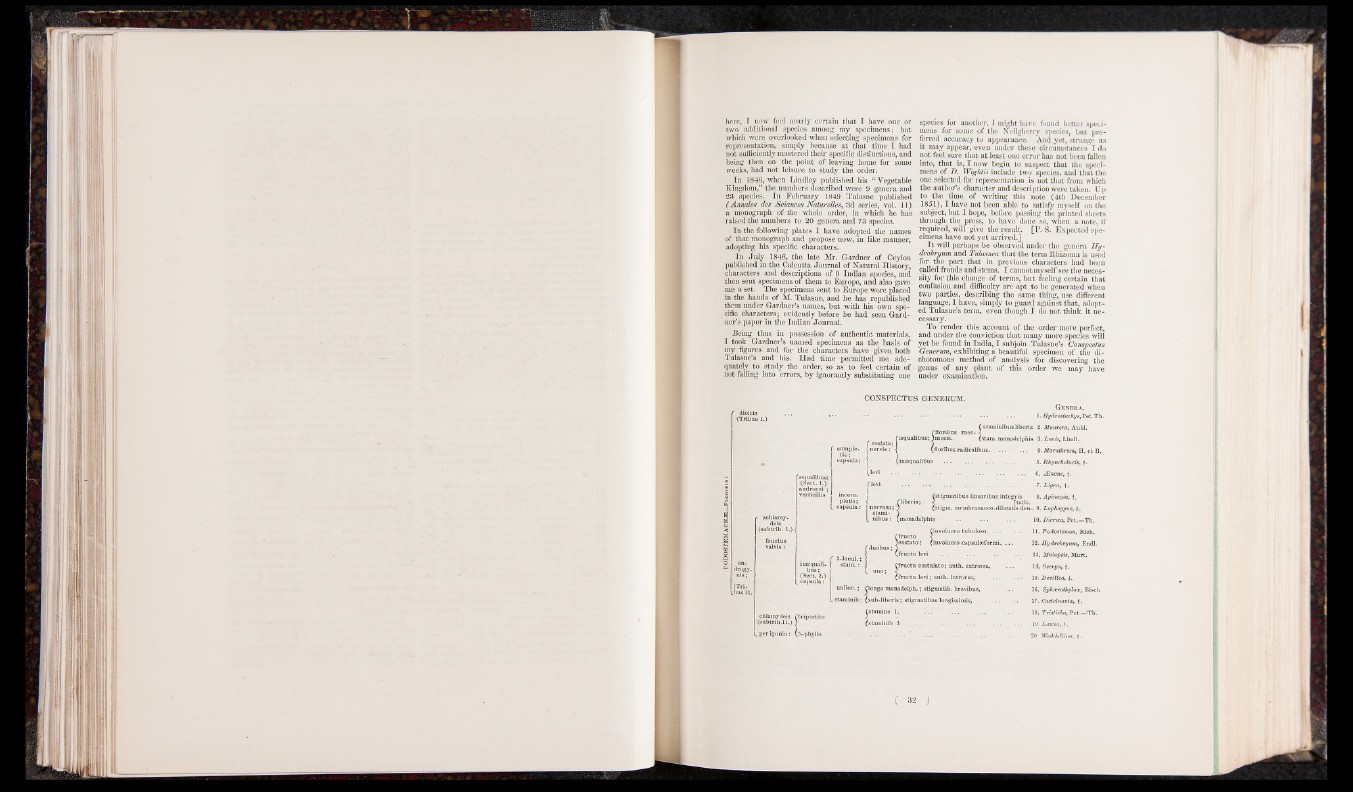
here, I now feel nearly certain that I have one or
two additional species among my specimens; but
which were overlooked when selecting specimens for
representation, simply because at that time I had
not sufficiently mastered their specific distinctions, and
being then on the point of leaving home for some
weeks, had not leisure to study the order.
In 1846, when Lindley published his “ Vegetable
Kingdom,” the numbers described were 9 genera and
23 species. In February 1849 Tulasne published
( Annales des Sciances Naturelles, 3d series, vol. 11)
a monograph of the whole order, in which he has
raised the numbers to 20 genera and 73 species.
In the following plates I have adopted the names
of that monograph and propose now, in like manner,
adopting his specific characters.
In July 1846, the late Mr. Gardner of Ceylon
published in the Calcutta Journal of Natural History,
characters and descriptions of 9 Indian species, and
then sent specimens of them to Europe, and also gave
me a set. The specimens sent to Europe were placed
in the hands of M. Tulasne, and he has republished
them under Gardner’s names, but with his own specific
characters; evidently before he had seen Gardner’s
paper in the Indian Journal.
Being thus in possession of authentic materials,
I took Gardner’s named specimens as the basis of
my figures and for the characters have given both
Tulasne’s and his. Had time permitted me adequately
to study the order, so as to feel certain of
not falling into errors, by ignorantly substituting one
species for another, I might have found better specimens
for some of the Neilglierry species, but preferred
accuracy to appearance. And yet, strange as
it may appeal*, even under these circumstances I do
not feel sure that at least one error has not been fallen
into, that is, I now begin to suspect that the specimens
of D. Wightii include two species, and that the
one selected for representation is not that from which
the author’s character and description were taken. Up
to the time of writing this note (4th December
-1851), I have not been able to satisfy myself on the
subject, but I hope, before passing the printed sheets
through the press, to have done so, when a note, if
required, will give the result. [P. S. Expected specimens
have not yet arrived.]
I t will perhaps be observed under the genera Hy-
drobryum and Tulasnea that the term Rhizoma is used
for the part that in previous characters had been
called fronds and stems. I cannot myself see the necessity
for this change of terms, but feeling certain that
confusion and difficulty are apt to be generated when
two parties, describing the same thing, use different
language, I have, simply to guard against that, adopted
Tulasne’s term, even though I do not think it necessary.
To render this account of the order more perfect,
and under the conviction that many more species will
yet be found in India, I subjoin Tulasne’s Conspectus
Generum, exhibiting a beautiful specimen of the dichotomous
method of analysis for discovering the
genus of any plant of this order we may have
under examination.
CONSPECTUS GENERUM.
comple- | n
eapsula; j
Genera.
1. Hydrostachys, Pet. Th.
( staminibusliberis. 2. Mourera, Aubl.
(stam. monadelphis 3. Lads, Lindl.
floribus radicalibus.
achlamydeis
(subtrib. !.)■ {
m b
[uali- f
uniloc.;
(. staminib:
fstigmatibus
(stigm. membranacec
(monadelphisfiuvolucro
tubuloso.
(involucl-o capsukefor
u levi
I ffructu costulato; anth. extrorsa,
(fructu levi; anth. introrsa,
flonge monadelph.; stigmatib. brevibus,
(sub-liberis; stigmatibus longissimis,
bus integris
fduobus;
4. Marathrum, H. et B.
5. Rhyncholacis, f.
6. JEncme, f.
7. Ligea, t.
8. Apinagia, f.
i-dilatatis den- 9. Lophogyne, f.
10. Dicrasa, Pet_Th.
................. 11. Podostemon, Rich.
mi. . . . 12. Hydrobryvm, Endl.
.. . . . 13. Mniopsis, Mart.
14. Oserya, f.
................. 15. DeviUea, +.
— 16. Sphcerothylax, Bisch
17. Castelnavia, f.
18. Trislicha, Pet.—Th.
................. 19. Latvia, f.
20 Weddellina, f.